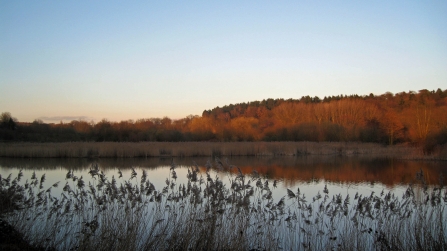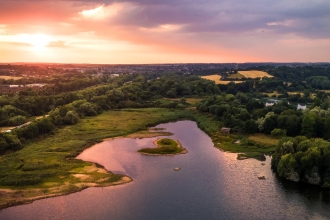Deep in the reed, something is stirring. Invisible at first, then a large yellow eye blinks. The toes of a bony green foot stretch out and a dagger-like beak snaps. A low ‘grrrrrr’ can just be heard above the swish of the wind-blown reeds.
Once bittern, twice shy...
Bittern © Jamie Hall
Bittern at Amwell Nature Reserve © Tim Hill
What sounds like a scene from a science-fiction movie is the experience of watching a bittern on a crisp winter morning. Due to their almost perfectly camouflaged brown and black plumage that makes them disappear between the reeds, bitterns are never an easy sight. With some patience and a bit of luck, you can find them skulking in their favoured home, wet reedbeds.
The bittern is a thickset bird from the heron family. One of its most distinctive features is its mating call, also called booming. It is a deep, fog-horn or bull-like call which can be heard from a great distance across the reedbeds. Male bitterns begin to boom as early as late January to establish territories and attract mates.
Their habitat, booming call and the fact that they were formerly common in Norfolk and Suffolk gave rise to a number of local names, including barrel-maker, bogblutter and bull of the bog. A long time ago, when reedbeds could be found up and down the country, the bittern was common and often hunted for the table. In some areas, it was called butterbump because their thick layer of fat would make it self-basting when cooked.
In some areas, it was called butterbump because their thick layer of fat would make it self-basting when cooked.
Today, bitterns are very rare and as a result have gained an unfavourable place in the amber category on the national list of species of conservation concern. From a low point of only 11 booming males in 1997, huge amounts of conservation work has been carried out such that in 2018, there were 188 booming males, recorded on 82 sites across the country. In winter, their numbers rise to around 600, with individuals migrating here from Europe. Their diet consists primarily of fish, so a crucial part in maintaining their population is to ensure there are reedbeds in water bodies which have sufficient fish of the a suitable size for bitterns to catch and eat.

Bittern Pool at Amwell © Graham Canny
Bitterns in Hertfordshire
At present, bitterns are a winter visitor in Hertfordshire but are not currently breeding here. The most reliable place to see bitterns in Hertfordshire is the Trust’s Amwell Nature Reserve in the Lea Valley, but it’s no happy accident that bitterns visit Amwell. The reserve is one of the most biodiverse in the country, a Site of Special Scientific Interest (SSSI) and part of the internationally important Lee Valley Special Protection Area (SPA). A carefully designed restoration plan complemented by targeted conservation work over the past 35 years have resulted in Amwell becoming a haven for wildlife and people, enjoyed by thousands of visitors every year.
In addition to Amwell, sightings of bitterns have also been made at Rye Meads, Tring Reservoirs, Hilfield Park Reservoir and Stocker’s Lake. With only 23 hectares of reedbed in Hertfordshire and probably only half of that wet and containing suitable fish populations, there is more work required to ensure bitterns continue to visit the county.




